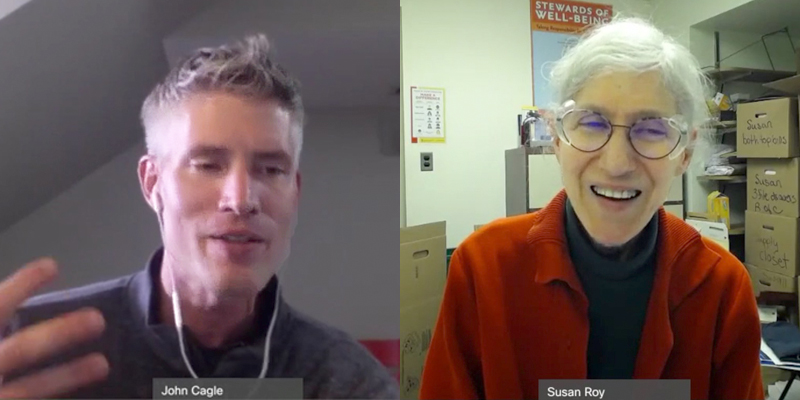April 2021
Grief, the experts tell us, is not an emotion like sadness, but a process by which we come to terms with loss. Seen through that lens, in different ways and for different reasons, we are all grieving right now.
Certainly, the families and friends of the 570,000 Americans who have died in this pandemic are suffering the greatest loss. Many of them were unable even to provide comfort in sickness or to be present at the end of life. And the need for social distancing has prevented or at least impeded the group rituals and practices like vigils for the dying and funerals that provide guidance and reassurance for survivors. Funerals held via Zoom, while not uncommon today, can’t offer the same depth of emotional support.

(l-r) John Cagle and Susan Carole Roy
About 31 million more Americans contracted COVID and survived. But there, too, is loss. The Centers for Disease Control and Prevention noted as early as last July that “prolonged symptom duration and disability are common in adults hospitalized with severe coronavirus disease.” As many as 80 percent of patients continue to have bothersome symptoms three months after the onset of COVID-19. A smaller, but troubling subset of survivors — the so-called “long-haulers” — may suffer from fatigue, body aches, shortness of breath, difficulty concentrating, inability to exercise, headache, and difficulty sleeping. Without certainty when or if those symptoms will subside, they are left in an emotional limbo, mourning the loss of the lives they knew.
Another group particularly hard hit are health care workers. A recent article in the Journal of Pain and Symptom Management calls health care workers “witnesses and victims both” and cautions that “special attention must be paid to our Health Care Worker (HCW) trainees, who may have not yet developed personal or professional grief management strategies and are coming into health care practice during a time of great disruption to both teaching and clinical care.” In an interview with USA Today, David Kessler, the founder of Grief.com, put it this way: “They’re [HCWs] always second-guessing themselves, wondering if they could do more. Nurses and doctors are seeing multiple deaths in a day, and they’re sitting with the anguish of the families. No one has been trained for this much death.”
Even those lucky enough to have never been directly impacted by COVID have experienced the loss of gatherings with family, social networks, freedom to travel, in-person classrooms, financial security, and even a feeling of safety and confidence about the future.
Writing in the journal Psychoneuroendocrinology, researchers from Rice University caution that the effects of grief, particularly long-term or “complicated grief,” may be as physically damaging as any disease. Among the list of grief-induced maladies are trouble sleeping, higher blood pressure, depression, even serious inflammation.
So, what is to be done? We have experienced loss, but the experience is not over. How can we process our loss, make sense of it, or at least reconcile it so we can move forward and live the best lives we can? And what can we do for our patients, colleagues, and families to help them?
On the April 22 edition of Virtual Face to Face with President Bruce Jarrell, substitute host and the Bill and Joanne Conway Dean of the University of Maryland School of Nursing Jane M. Kirschling, PhD, RN, FAAN, explored these issues with two guest experts. Rev. Susan Carole Roy, DMin, BCC, is director of pastoral care services at the University of Maryland Medical Center. She has served in that role for nearly 24 years, providing spiritual care, crisis intervention, family conferences, consultation on end-of-life issues, and help with treatment decisions. Roy was joined by John Cagle, PhD, MSW, associate professor in the University of Maryland School of Social Work. His work has focused on end-of-life, hospice, and palliative care issues, identifying effective models of care and support for dying patients and their families — and implementing those models into routine clinical practice. His research is informed by nearly a decade of clinical work as a hospice social worker.
Watch their discussion, including questions from the audience, by accessing the link at the top of this page.
Search UMB News
Sign up for UMB Alerts.



